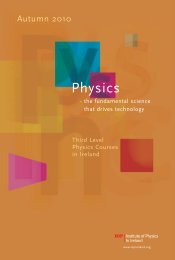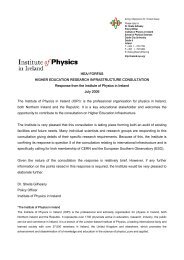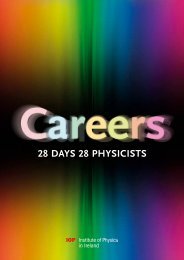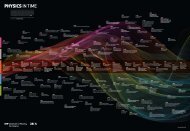PHY ICS - The Institute of Physics in Ireland
PHY ICS - The Institute of Physics in Ireland
PHY ICS - The Institute of Physics in Ireland
You also want an ePaper? Increase the reach of your titles
YUMPU automatically turns print PDFs into web optimized ePapers that Google loves.
38 P H Y S I C S O N S T A G E 2<br />
EASY COLOUR<br />
<strong>The</strong> next five items are simple modifications <strong>of</strong> standard experiments. <strong>The</strong>se methods<br />
make use <strong>of</strong> readily available or cheap materials. Good quality COLOUR FILTERS<br />
have many uses and a handy source is to cut up the large sheets available for a few<br />
Euro each from theatre light<strong>in</strong>g suppliers such as Stage Light<strong>in</strong>g Centre <strong>of</strong>f Pearse St.<br />
Dubl<strong>in</strong> (01-677 3044). Choose colours carefully from the large range available.<br />
I f<strong>in</strong>d these three <strong>in</strong> the LEE Filters series work well: Nos : 106, 139 and 363.<br />
<strong>The</strong>y are PRIMARY RED, PRIMARY GREEN and SPECIAL MEDIUM BLUE.<br />
EASY COLOUR 1: Explor<strong>in</strong>g white light<br />
No need for specialised equipment. One easy way to get a narrow beam <strong>of</strong><br />
parallel white light is to tape two small pieces <strong>of</strong> opaque card to an empty 35mm<br />
slide mount with a gap just less than 1mm between them. Put the slide <strong>in</strong> the<br />
projector, place a triangular glass prism a few cm <strong>in</strong> front <strong>of</strong> the projector lens<br />
to get a spectrum on a screen or the ceil<strong>in</strong>g. For best results rotate the prism to<br />
get the m<strong>in</strong>imum angle <strong>of</strong> deviation and focus the projector. Now ask your<br />
students what a red filter does to white light. Introduce one and see how only<br />
the green and blue are absorbed – and so on for the other primary colours.<br />
(To use an overhead projector <strong>in</strong>stead, get two opaque cards about A4 size and place<br />
them on the stage with a gap <strong>of</strong> a few mm between them. Aga<strong>in</strong> hold a prism <strong>in</strong> front<br />
<strong>of</strong> the lens and adjust the gap, and the focuss<strong>in</strong>g, to get the clearest spectrum on a<br />
screen or ceil<strong>in</strong>g.)













